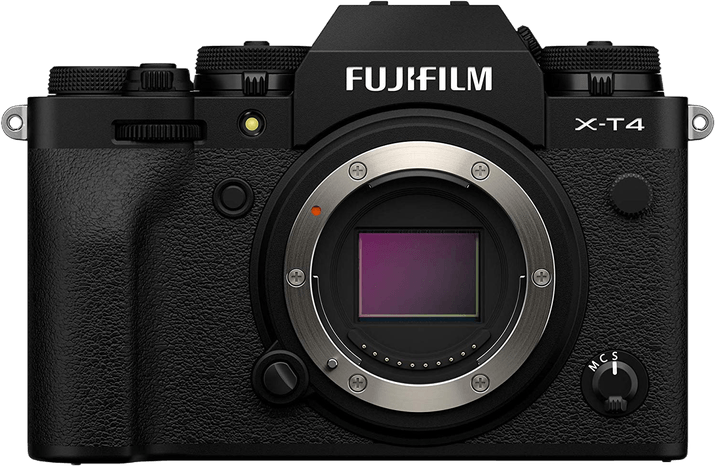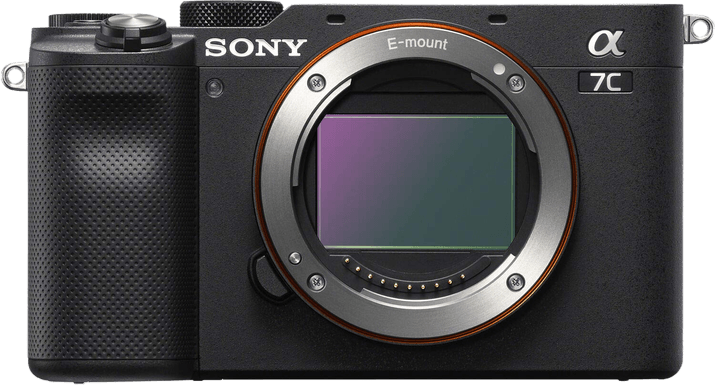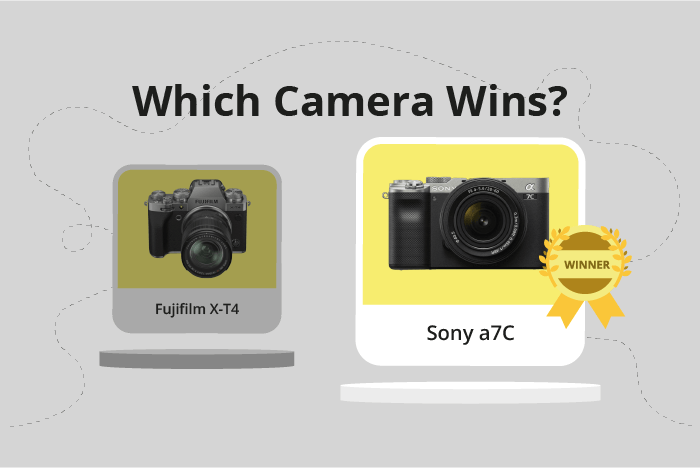Fujifilm X-T4 vs Sony a7C Comparison
Fujifilm X-T4

Sony a7C

The Sony a7C edges out the Fujifilm X-T4 with a score of 78/100 compared to the X-T4’s 76/100. Both cameras are mirrorless and were released in 2020, with the X-T4 priced at $1699 and the a7C at $1799. They share some common specifications, but there are notable differences.
The Fujifilm X-T4 is larger, measuring 135 x 93 x 84mm, and weighing 607g (1.34lbs). This size and weight advantage make it more robust and suitable for demanding photography situations. On the other hand, the Sony a7C is more compact and lightweight, measuring 124 x 71 x 60mm, and weighing 509g (1.12lbs), making it an ideal choice for photographers who prioritize portability and ease of use.
Considering these specifications, the Sony a7C is the winner due to its higher score and compact size, while the Fujifilm X-T4 offers a solid alternative for those seeking a more rugged option.
Fujifilm X-T4 vs Sony a7C Overview and Optics
The Sony a7C outperforms the Fujifilm X-T4 in optics with a score of 80/100, while the X-T4 has a score of 73/100. Both cameras share several specifications, including a CMOS sensor, image stabilisation, and similar megapixel counts (26 for the X-T4 and 24.2 for the a7C). They also have their respective lens mounts, the Fujifilm X for the X-T4 and the Sony FE for the a7C.
The Sony a7C takes the lead with its full-frame sensor, resulting in better image quality and low-light performance compared to the Fujifilm X-T4’s APS-C sensor. Additionally, the a7C has a DXOMARK score of 95 for its sensor, which is a reliable indicator of its superior image quality. The Bionz X processor in the a7C also contributes to faster image processing and better noise reduction.
Despite its lower score, the Fujifilm X-T4 has some advantages. It offers a faster shooting speed of 20 frames per second (fps), making it more suitable for action and sports photography compared to the Sony a7C’s 10 fps. The X-T4 also boasts a higher megapixel count, providing slightly more detail and flexibility in post-processing.
In terms of optics, the Sony a7C is the better choice for photographers who prioritize image quality and low-light performance, thanks to its full-frame sensor and higher DXOMARK score. On the other hand, the Fujifilm X-T4 is more suitable for those who require faster shooting speeds and slightly higher resolution. Both cameras offer image stabilisation and a variety of lenses through their respective lens mounts, ensuring versatility for different shooting scenarios.
Fujifilm X-T4 vs Sony a7C Video Performance
The Fujifilm X-T4 outperforms the Sony a7C in video capabilities, scoring 91/100 compared to the a7C’s 70/100. Both cameras share some common features, such as 4K video resolution and built-in time-lapse functionality. However, the X-T4 surpasses the a7C in several aspects, making it the superior choice for videography.
The Fujifilm X-T4 offers higher maximum video dimensions at 4096 x 2160, compared to the Sony a7C’s 3840 x 2160. This difference provides the X-T4 with a larger, more detailed video output. Additionally, the X-T4 has a significantly higher maximum video frame rate, reaching 120fps, while the a7C only reaches 30fps. This allows the X-T4 to capture smoother, more fluid motion, especially in fast-paced scenes or when recording slow-motion footage.
On the other hand, the Sony a7C does not have any notable advantages over the Fujifilm X-T4 in terms of video capabilities. Both cameras share the 4K video resolution and built-in time-lapse functionality, but the a7C falls short in other areas, such as maximum video dimensions and frame rate.
Considering the differences in video capabilities, the Fujifilm X-T4 is the clear winner. With its larger maximum video dimensions and higher frame rate, the X-T4 provides better image quality and smoother motion capture. The Sony a7C, although sharing some common features with the X-T4, does not offer any additional advantages in video performance. Therefore, for videography purposes, the Fujifilm X-T4 is the superior choice between these two cameras.
Fujifilm X-T4 vs Sony a7C Features and Benefits
The Fujifilm X-T4 outperforms the Sony a7C with a feature score of 85/100 compared to the latter’s 81/100. Both cameras share several specifications, including a 3-inch screen size, touchscreen capabilities, flip screen, GPS, Wi-Fi, and Bluetooth connectivity.
The X-T4 surpasses the a7C in screen resolution, boasting 1,620,000 dots compared to the a7C’s 921,600 dots. This higher resolution allows for sharper and more detailed image previews, enhancing the user experience and making it easier to review and edit photos on the camera.
On the other hand, the Sony a7C still offers a competitive feature set despite its slightly lower score. It shares many of the same essential features as the X-T4, making it a viable option for photographers who prioritize compactness and a more straightforward interface. However, the lower screen resolution may be a drawback for some users.
When comparing the two cameras, the Fujifilm X-T4’s superior screen resolution sets it apart from the Sony a7C, making it a better choice for photographers who value image quality and detail. The Sony a7C remains a strong contender, but its lower resolution may deter those who prioritize image clarity. Both cameras offer a range of features suitable for various photography needs, but the X-T4 has a slight edge in this aspect.
Fujifilm X-T4 vs Sony a7C Storage and Battery
The Fujifilm X-T4 surpasses the Sony a7C in storage and battery with a score of 73/100, while the Sony a7C scores 45/100. Both cameras accept SD, SDHC, and SDXC memory cards (UHS-II compatible) and offer USB charging.
The X-T4 outshines the a7C with two memory card slots, doubling the storage capacity. This advantage allows photographers to manage their files more efficiently. However, the a7C excels in battery life, providing 740 shots per charge compared to the X-T4’s 500 shots. The Sony a7C uses the NP-FZ100 battery, while the Fujifilm X-T4 relies on the NP-W235 battery.
Despite the a7C’s longer battery life, the X-T4’s superior storage capabilities make it the winner in this comparison. The X-T4’s dual memory card slots provide more flexibility, while the a7C’s extended battery life might not compensate for its single memory card slot.
Fujifilm X-T4 vs Sony a7C – Our Verdict
Are you still undecided about which camera is right for you? Have a look at these popular comparisons that feature the Fujifilm X-T4 or the Sony a7C:

